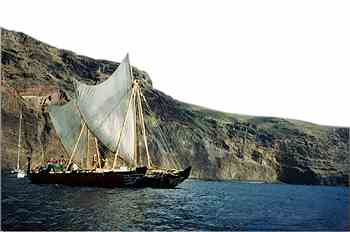Ara-Moana is a replica of an early voyaging canoe from the Tonga- and Samoa-region in the Central Pacific. It is navigated by the use of the sails and three steeringoars astern. For practical and safety reasons the applied materials are modern.
The two hulls are build as a sandwich construction of divinycell and glassfiber, and are connected by 19 crossbeams secured by approximately 5 km of nylonlines. According to the tradition there is neither keel nor rudder, but the boat is steered by the help of the sails and three steeringoars astern. Two short alongside each hull and one long oar midship (Babyan et al., Journal of Polynesian Society 1986).
Ara-Moana is equipped with two A-masts, each with a leg in either canoe. The two dacronsails hangs between the legs of each mast, which gives a limited use, but in return a very strong construction. A-masts are known from among other New Guinea ("Cooks Voyages") and Hawaii (Best "The Maori Canoe").
The sails are so-called crabclaw sails or half moon sails, which can be found all over the Pacific. Two curved bars forms a V with the point turned towards the deck. Like this the greatest sail area is at the top.
Length: 21 m Beam: 7 m Waterline: 18 m
Height of hull: 2 m Hull thickness: 40 mm Draught: 0,8 m
Deckarea: 130 m2 Deplacement: 16.500 kg Nettotonnage: 5 registerton
Bruttotonnage: 17 registerton Foresail: 36 m2 Aftersail: 22 m2


